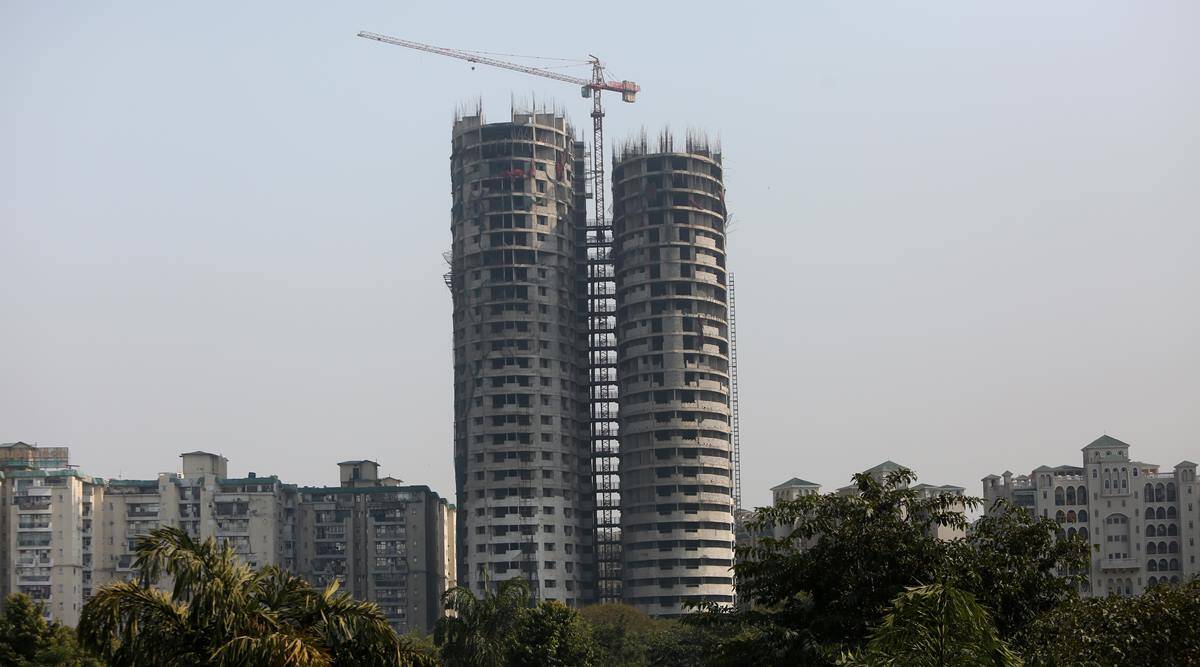 The towers are being demolished on the orders of the Supreme Court, and will be razed to the ground by May 22. (Gajendra Yadav)
The towers are being demolished on the orders of the Supreme Court, and will be razed to the ground by May 22. (Gajendra Yadav) The limited time to prepare the Supertech towers for demolition ahead of the tentative completion date of May 22 could be a challenge for those tasked with bringing the twin towers down.
On Sunday, a ‘test blast’ was done, with a small quantity of explosives inserted to determine what quantity will be necessary for the building. This is to ensure that the quantity of explosives used is not too little or too much. Five columns were blasted as part of the test blast.
“Preparation time is a big challenge because of the amount of work to be put in,” said Uttkarsh Mehta, Partner, Edifice Engineering, which is the company executing the demolition.
“There are a lot of shear walls, which are long walls of concrete of about 10 metres. Preparing them is a task. We are creating gaps in them and making them individual columns before they are blasted,” he said. The firm had executed the demolition of apartment complexes in Kochi in 2020 that had violated Coastal Regulation Zone norms. “The difference between the Kochi and Noida demolitions is that there are more shear walls here, which increases the preparation time,” Mehta added.
Ahead of demolition of the illegally built Supertech twin towers in Noida, a test blast was carried out on Sunday afternoon. Residents of the nearby societies were asked to stay indoors during the period. pic.twitter.com/UBSLsHMxxx
— Express Delhi-NCR 😷 (@ieDelhi) April 10, 2022
“I see time as a critical factor for us. However, if our experts are not confident about the preparation of the building, we will not blast. By the end of April, we will be able to give an exact date. As of now, it is May 22. We were running late since the 9m driveway was not handed over earlier,” Mehta said.
Jet Demolition, a South African company that is collaborating with Edifice Engineering, has designed and will supervise the implosion. The company had executed the demolition of the 108-m-tall Bank of Lisbon building in Johannesburg in 2019, and the Supertech buildings are smaller at 97 m and 103 m, Mehta said. “In that demolition, the adjacent building, one with glass cladding, was only 7.8 m away. The glass didn’t crack, and the debris was within the boundary wall. After that, there was the Kochi job, where the buildings were around 60 m tall. It went perfectly well.”
“The taller the building, the better it is for an implosion,” Mehta said, explaining that the implosion is based on the weight of the building. “We are blasting the column, and the slabs at the top need to fall. More the weight, the better control it will have.”
A survey is being held to demarcate the exclusion zone – the area that will have to be evacuated for a few hours on the day of the blast.
Precautions are being taken to prevent the debris from spilling over onto the adjacent building. The columns of the Supertech towers are being wrapped with layers of chain-link fencing and geotextile cloth to prevent the debris from flying out. Geotextile cloth will also be used to cover the adjacent apartment complex about three to four days before the demolition date.
Preparatory work is underway at the site. Internal and external walls are being removed, and holes are being drilled into the columns for the explosives. The podium at the ground level has been demolished.
To monitor the vibrations that the implosion can cause, the firm has approached IIT-Madras. “We will have impact cushions at the bottom. There will be vibrations, but within permissible limits…even lower than the earthquakes we are already facing here. Vibrations…we don’t see any major concerns. Debris going somewhere is a concern, which we are trying to protect. 99.9% it won’t damage anything. What can be caused is the dust, which we have no means to control,” Mehta said.
The company is preparing a plan to dispose of the debris. Mehta estimates that around 40,000 tonnes of debris could be generated.
- The Indian Express website has been rated GREEN for its credibility and trustworthiness by Newsguard, a global service that rates news sources for their journalistic standards.

